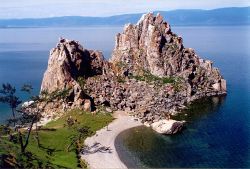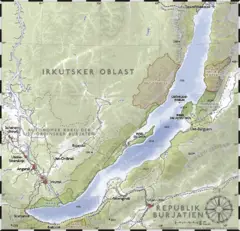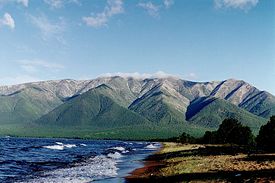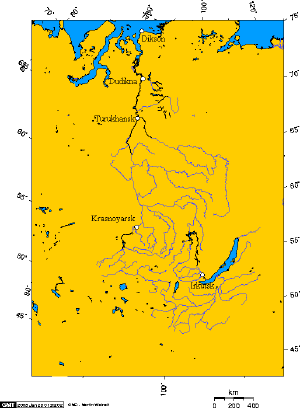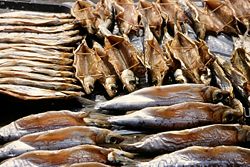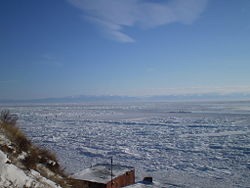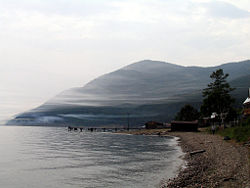Difference between revisions of "Lake Baikal" - New World Encyclopedia
Dan Davies (talk | contribs) (Information map changed) |
Dan Davies (talk | contribs) (updated Wikipedia version) |
||
| Line 25: | Line 25: | ||
|frozen = January-May | |frozen = January-May | ||
}} | }} | ||
| − | '''Lake Baikal''' ( | + | '''Lake Baikal''' ({{lang-ru|о́зеро Байка́л ''Ozero Baykal''}}, {{pronounced|ˈozʲɪrə bʌjˈkɑl}}, {{lang-bxr|Байгал нуур ''Baygal nuur''}}) is in Southern [[Siberia]] in [[Russia]], located between [[Irkutsk Oblast]] to the northwest and the [[Buryatia|Buryat Republic]] to the southeast, near the city of [[Irkutsk]]. It is also known as the "Blue Eye of Siberia". It contains more water than all the North American [[Great Lakes]] combined. <ref name="cnn">{{cite web |
|url=http://www.cnn.com/SPECIALS/2000/russia/story/train/lake.baikal/ | |url=http://www.cnn.com/SPECIALS/2000/russia/story/train/lake.baikal/ | ||
|title=Lake Baikal: the great blue eye of Siberia | |title=Lake Baikal: the great blue eye of Siberia | ||
|publisher=CNN.com | |publisher=CNN.com | ||
| − | |accessdate= | + | |accessdate=2006-10-21 |
| − | }}</ref><ref | + | }}</ref><ref name="oddities"/> |
| − | |||
| − | |||
| − | |||
| − | |||
| − | |||
| − | Lake Baikal is the [[List of lakes by | + | At {{m to ft|1637|precision=0}}, Lake Baikal is the deepest lake in the world<ref>{{cite web |
| + | |year= | ||
| + | |month= | ||
| + | |url=http://geology.com/records/deepest-lake.shtml | ||
| + | |title=Deepest Lake in the World | ||
| + | |publisher=geology.com | ||
| + | |accessdate=2007-08-18 | ||
| + | }}</ref>, and the [[List of lakes by volume|largest freshwater lake]] in the world by volume, holding approximately twenty percent of the world's total surface fresh water.<ref name="touchstone">U.S. Geological Survey [http://marine.usgs.gov/fact-sheets/baikal/ Fact Sheet: Lake Baikal — A Touchstone for Global Change and Rift Studies], July 1993 (accessed February 10, 2007)</ref> Like [[Lake Tanganyika]], Lake Baikal was formed in an ancient [[rift valley]] and therefore is long and crescent-shaped with a surface area (31,500 km²) less than half that of [[Lake Superior]] or [[Lake Victoria]]. Baikal is home to more than 1,700 species of plants and animals, two thirds of which can be found nowhere else in the world<ref> "Russia." Britannica Student Encyclopedia. 2007. Encyclopædia Britannica Online. 3 July 2007 [http://www.britannica.com/ebi/article-207539]</ref> and was declared a [[UNESCO]] [[World Heritage Site]] in 1996.<ref>{{cite web | ||
|url=http://whc.unesco.org/en/list/754 | |url=http://whc.unesco.org/en/list/754 | ||
| − | |title=Lake Baikal | + | |title=Lake Baikal — World Heritage Site |
|publisher=World Heritage | |publisher=World Heritage | ||
| − | |accessdate= | + | |accessdate=2007-01-13 |
| − | }}</ref> | + | }}</ref> At more than 25 million years old, it is the oldest lake in the world.<ref name="touchstone">[http://marine.usgs.gov/fact-sheets/baikal/ Fact Sheet: Lake Baikal — A Touchstone for Global Change and Rift Studies], July 1993 (accessed December 04, 2007)</ref> |
| − | |||
| − | |||
| − | |||
| − | |||
| − | |||
| − | == Geography and hydrography == | + | ==Geography and hydrography== |
| − | + | [[Image:-26 swiatoinos.JPG.JPG|thumb|275px|left|The peninsula of [[Svyatoy Nos]].]] | |
| + | While Lake Baikal was known as the "North Sea" in historical Chinese texts, it was situated in the then Xionu territory and very little was known about Lake Baikal until the [[Trans-Siberian railway]] was built between 1896 and 1902. | ||
| + | The scenic loop encircling Lake Baikal needed 200 bridges and 33 tunnels. As this railway was being built, a large hydrogeographical expedition headed by [[Fedor Kirillovich Drizhenko|F.K. Drizhenko]] produced the first detailed atlas of the contours of Baikal's depths. The atlas demonstrated that Lake Baikal has more water than all of [[North America]]'s [[Great Lakes]] combined — {{km3 to mi3|23600}}, about one fifth of the total fresh water on the earth. However, in surface area, it is exceeded by the much shallower Great Lakes [[Lake Superior|Superior]], [[Lake Huron|Huron]] and [[Lake Michigan|Michigan]] in [[North America]], as well as by the relatively shallow [[Lake Victoria]] in [[East Africa]].<ref>{{cite web | ||
|url=http://www.tahoebaikal.org/lakeinfo/ | |url=http://www.tahoebaikal.org/lakeinfo/ | ||
|title=Lake Tahoe and Lake Baikal Watersheds | |title=Lake Tahoe and Lake Baikal Watersheds | ||
|publisher=Tahoe-Baikal Institute | |publisher=Tahoe-Baikal Institute | ||
| − | |accessdate= | + | |accessdate=2006-10-21 |
| − | }}</ref> Known as the "[[Galápagos Islands|Galápagos]] of Russia, | + | }}</ref> Known as the "[[Galápagos Islands|Galápagos]] of Russia", its age and isolation have produced some of the world's richest and most unusual [[fish|freshwater fauna]], which is of exceptional value to [[evolution|evolutionary science]].<ref name="touchstone">{{cite web |
|url=http://marine.usgs.gov/fact-sheets/baikal/ | |url=http://marine.usgs.gov/fact-sheets/baikal/ | ||
| − | |title=Lake Baikal | + | |title=Lake Baikal — A Touchstone for Global Change and Rift Studies |
|publisher=U.S. Geological Survey | |publisher=U.S. Geological Survey | ||
| − | |accessdate= | + | |accessdate=2006-10-21 |
| − | }}</ref> | + | }}</ref> |
| + | |||
| + | Lake Baikal is in a [[rift valley]] created by the [[Baikal Rift Zone]], where the crust of the earth is pulling apart.<ref name="oddities">{{cite web | ||
| + | |url=http://www.gi.alaska.edu/ScienceForum/ASF9/986.html | ||
| + | |title=The Oddities of Lake Baikal | ||
| + | |publisher=Alaska Science Forum | ||
| + | |accessdate=2007-01-07 | ||
| + | }}</ref> | ||
| + | At {{km to mi|636}} long and {{km to mi|79}} wide, Lake Baikal has the largest surface area of any freshwater lake in [[Asia]] ([[1 E10 m²|31,494 km²]]) and is the deepest lake in the world (1,637 metres, previously measured at 1,620 metres). The bottom of the lake is 1,285 metres below sea level, but below this lies some {{km to mi|7|precision=1}} of [[sediment]], placing the rift floor some 8–9 kilometers (more than 5 miles) below the surface: the deepest continental [[rift]] on [[Earth]].<ref name="oddities"/> | ||
| + | In geological terms, the rift is young and active—it widens about two centimeters per year. The fault zone is also seismically active: there are hot springs in the area and notable earthquakes every few years. It drains into the [[Angara]] tributary of the [[Yenisei]]. | ||
| + | [[Image:Yenisei basin 7.png|thumb|The [[Yenisei River]] basin, Lake Baikal, and the settlements of [[Dikson (urban-type settlement)|Dikson]], [[Dudinka]], [[Turukhansk]], [[Krasnoyarsk]], [[Irkutsk]].|left]] | ||
| + | |||
| + | Its age is estimated at [[1 E14 s|25–30 million years]], making it one of the most ancient lakes in [[geology|geological]] history. It is unique among large, high-latitude lakes in that its [[sediment]]s have not been scoured by overriding continental ice sheets. US and Russian studies of core sediment in the 1990s provide a detailed record of climatic variation over the past 250,000 years. Longer and deeper sediment cores are expected in the near future. Lake Baikal is furthermore the only confined fresh water lake in which direct and indirect evidence of [[gas hydrate]]s exists.<ref>Kuzmin, M.I., et al., 1998. First find of gas hydrates in sediments of Lake Baikal. Doklady Adademii Nauk, 362: 541-543 (in Russian).</ref><ref>Vanneste, M., et al., 2001. Multi-frequency seismic study of gas hydrate-bearing sediments in Lake Baikal, Siberia. Marine Geology, 172, 1-21.</ref><ref>Van Rensbergen, P., et al., 2002. Sub-lacustrine mud volcanoes and cold seeps caused by dissociation of gas hydrates in Lake Baikal. Geology, 30(7), 631-634.</ref> | ||
| + | |||
| + | The lake is completely surrounded by mountains. The [[Baikal Mountains]] on the north shore and the [[taiga]] are technically protected as a national park. It contains 22 islands; the largest, [[Olkhon]], is {{km to mi|72}} long. The lake is fed by as many as three hundred and thirty inflowing rivers.<ref name="cnn"/> The main ones draining directly into Baikal are the [[Selenga River]], the [[Barguzin River]], the [[Upper Angara River]], the [[Turka River]], the [[Sarma River]] and the [[Snezhnaya River]]. It is drained through a single outlet, the [[Angara River]]. | ||
| + | |||
| + | Despite its great depth, the lake's waters are well-mixed and well-oxygenated throughout the water column compared to the [[Stratification (water)|stratification]] that occurs in such bodies of water as [[Lake Tanganyika]] and the [[Black Sea]]. | ||
| + | |||
| + | [[Olkhon]], the largest island in Lake Baikal, is the fourth-largest [[List of islands in lakes|lake-bound island in the world]]. | ||
| + | |||
| + | ==Wildlife== | ||
| + | [[Image:Omul Fish.jpg|thumb|250px|Omul Fish at the [[Listvyanka]] market.]] | ||
| − | + | The extent of [[biodiversity]] present in Lake Baikal is equaled by few other lakes. Lake Baikal hosts 1,085 species of plants and 1,550 species and varieties of animals. Over 80% of animals are [[Endemic (ecology)|endemic]]. [[Epischura baikalensis]] is endemic to Lake Baikal and the dominating [[zooplankton]] species there: 80 to 90 percent of total [[Biomass (ecology)|biomass]].<ref>[http://www.obaykale.ru/baykal-fauna_06.htm Зоопланктон в экосистеме озера Байкал / О Байкале.ру - Байкал. Научно и популярно<!-- Bot generated title —>]</ref> The [[Baikal Seal]] or [[nerpa]] (''Phoca sibirica''), is found throughout Lake Baikal. It is one of only 3 entirely freshwater [[phocid|seal]] species in the world, the other being the two subspecies of freshwater [[Ringed Seal]]. Perhaps the most important local species is the [[omul]] (''Coregonus autumnalis migratorius''), a smallish endemic [[salmonid]]. It is caught, [[Smoking (food)|smoked]], and sold widely in markets around the lake. | |
| − | |||
| − | [ | ||
| − | + | Of particular note are the two species of [[golomyanka]] or Baikal oil fish (''Comephorus baicalensis'' and ''C. dybowskii''). These long-finned, translucent fish live in depths of 700 to 1600 feet and are the primary prey objects of the Baikal seal, representing the largest fish biomass in the lake. They are famous for disintegrating into a pool of oil and bones when withdrawn rapidly from the high pressures of the deep water. The Baikal [[Grayling (genus)|grayling]] (''Thymallus arcticus baicalensis''), a fast swimming [[salmonid]] popular among anglers, and the [[Baikal sturgeon]] (''Asipenser baerri baicalensis'') are both important endemic species with commercial value. | |
| − | + | [[Bear]] and [[deer]] are common and hunted along Baikal shores. | |
| − | + | ==Research== | |
| + | Several organizations are carrying out natural research projects on Lake Baikal. Most of them are governmental or associated with governmental organizations. The | ||
| + | [[Baikalian Research Centre]] is an independent research organization carrying out environmental educational and research project at Lake Baikal.<ref> | ||
| + | {{cite web | ||
| + | |url=http://www.lakebaikal.net/ | ||
| + | |title=Baikalian Research Centre (ANO) (in Russian) | ||
| + | |publisher=www.lakebaikal.net | ||
| + | |accessdate=2008-07-05}}</ref> | ||
| − | + | On [[July]], 2008, Russia announced sending 2 small [[submersibles]], [[Mir-1]] and [[Mir-2]], to descend 1 mile to the bottom of Lake Baikal, to conduct geological and biological tests, about its unique ecosystem. Famous scientist and federal politician [[Artur Chilingarov]] will also join the 60 dives.<ref>[http://ukpress.google.com/article/ALeqM5iSNtoPecSfX9Qp3Yi4LilKLU1wjA ukpress.google.com/, Submarines to plumb deepest lake]</ref> | |
| − | |||
| − | |||
| − | |||
| − | |||
| − | |||
| − | == | + | ==Tourism== |
| − | [[Image: | + | [[Image:Lakebaikalwinter.jpg|thumb|250px|The lake in the winter, as seen from the tourist resort of [[Listvyanka]]. The ice is thick enough to support pedestrians and snowmobiles.]] |
| − | The | + | The lake called "''the Pearl of Siberia''" drew investors from the tourist industry since energy revenues sparked an economic boom.<ref>{{cite web |
| + | |author=Tom Esslemont | ||
| + | |year=2007 | ||
| + | |month=September 7 | ||
| + | |url=http://news.bbc.co.uk/2/hi/europe/6982271.stm | ||
| + | |title= 'Pearl of Siberia' draws investors | ||
| + | |publisher=BBC News | ||
| + | |accessdate=2007-12-04 | ||
| + | }}</ref> | ||
| + | Viktor Grigorov's Grand Baikal in [[Irkutsk]] is one of the [[investors]] who planned to build three hotels creating 570 jobs. In 2007, the Russian government declared the Baikal region a [[special economic zone]]. The popular [[resort]] of Listvyanka has a seven-story Hotel Mayak. Baikal is a [[UNESCO]] [[World Heritage]] site. ''[[Rosatom]]'' plans to build a [[laboratory]] in Baikal, in conjunction with an international [[uranium]] plant and to invest $2.5bn in the region and create 2,000 jobs in the city of [[Angarsk]].<ref>[http://news.bbc.co.uk/2/hi/europe/6982271.stm BBC NEWS, 'Pearl of Siberia' draws investors]</ref> | ||
| − | + | ==Environmental concerns== | |
| + | ===Baykalsk pulp and paper mill=== | ||
| + | [[Image:Baikal south.jpg|thumb|250px|The lake in the summer, as seen from [[Bolshiye Koty]] on the southwest shore.]] | ||
| − | [[ | + | Baykalsk Pulp and Paper Mill (BPPM) was constructed in 1966 directly on the shore line. The BPPM [[bleach]]es its paper with [[chlorine]] and discharges the waste into Baikal. Despite numerous protests, the BPPM is still in production. [[Environmentalist|Environmental activists]] are now struggling to make the pollution less harmful rather than end BPPM's production since a plant shutdown would destroy valuable jobs. |
| − | == | + | ===Planned East Siberia-Pacific Ocean oil pipeline=== |
| − | + | {{Main|Eastern Siberia – Pacific Ocean oil pipeline}} | |
| − | |||
| − | |||
| − | + | Russian oil pipelines state company [[Transneft]]<ref>{{cite web | |
| − | |||
| − | |||
|url=http://www.transneft.ru/Default.asp?LANG=EN Transneft | |url=http://www.transneft.ru/Default.asp?LANG=EN Transneft | ||
|title=Transneft | |title=Transneft | ||
| − | |publisher= | + | |publisher=Transneft |
| − | |accessdate= | + | |accessdate=2006-10-21 |
| − | }}</ref> was planning to build a trunk pipeline that would have come within | + | }}</ref> was planning to build a trunk pipeline that would have come within {{m to ft|800|precision=-1}} of the lake shore in a zone of substantial seismic activity. Environmental activists in Russia,<ref>{{cite web |
|url=http://www.baikalwave.eu.org/Eng/index-e.html | |url=http://www.baikalwave.eu.org/Eng/index-e.html | ||
|title=Baikal Environmental Wave | |title=Baikal Environmental Wave | ||
|publisher= | |publisher= | ||
| − | |accessdate= | + | |accessdate=2006-10-21 |
| − | }}</ref> Greenpeace, Baikal pipeline opposition and local citizens<ref>{{cite web | + | }}</ref> Greenpeace, Baikal pipeline opposition<ref>{{cite web |
| + | |url=http://baikal-pipe.net/?page_id=64 | ||
| + | |title=Baikal pipeline | ||
| + | |publisher= | ||
| + | |accessdate=2006-10-21 | ||
| + | }}</ref> and local citizens<ref>{{cite web | ||
|url=http://www.baikalwave.eu.org/Eng/news.html#a2 | |url=http://www.baikalwave.eu.org/Eng/news.html#a2 | ||
|title=The Right to Know: Irkutsk Citizens Want to be Consulted | |title=The Right to Know: Irkutsk Citizens Want to be Consulted | ||
|publisher= | |publisher= | ||
| − | |accessdate= | + | |accessdate=2007-01-07 |
| − | }}</ref> were strongly opposed to these plans due to the possibility of an accidental oil spill that might cause significant damage to the environment. According to the Transneft's president, numerous meetings with ordinary citizens were held in towns along the route, especially in [[Irkutsk]]. | + | }}</ref> were strongly opposed to these plans due to the possibility of an accidental oil spill that might cause significant damage to the environment. According to the Transneft's president, numerous meetings with ordinary citizens were held in towns along the route, especially in [[Irkutsk]].<ref>{{cite web |
| + | |url=http://spb.ecology.net.ru/enwl/2006/03/15_16.htm | ||
| + | |title=Тема: [ENWL] Власти Иркутской обл. выступили против прокладки нефтепровода к Тихому океану | ||
| + | |publisher= | ||
| + | |accessdate=2007-08-03 | ||
| + | }} | ||
| + | </ref> However, it was not until Russian president [[Vladimir Putin]] ordered the company to consider an alternative route {{km to mi|40}} to the north to avoid such ecological risks that Transneft agreed to alter its plans.<ref>{{cite web | ||
|year=2006 | |year=2006 | ||
|month=April 26 | |month=April 26 | ||
| Line 115: | Line 153: | ||
|title=Putin orders oil pipeline shifted | |title=Putin orders oil pipeline shifted | ||
|publisher=BBCNews | |publisher=BBCNews | ||
| − | |accessdate= | + | |accessdate=2006-10-21 |
| − | + | }}</ref> Transneft has since decided to move the pipeline away from Lake Baikal so that it will not pass through any federal or republic natural reserves.<ref>{{cite web | |
| − | |||
| − | |||
| − | |||
| − | |||
| − | }}</ref> has since decided to move the pipeline away from Lake Baikal so that it will not pass through any federal or republic natural reserves.<ref>{{cite web | ||
|url=http://www.rbcnews.com/free/20060907165225.shtml | |url=http://www.rbcnews.com/free/20060907165225.shtml | ||
|title=Transneft charged with Siberia-Pacific pipeline construction | |title=Transneft charged with Siberia-Pacific pipeline construction | ||
|publisher=BizTorg.ru | |publisher=BizTorg.ru | ||
| − | |accessdate= | + | |accessdate=2006-10-21 |
| − | }}</ref> <ref>{{cite web | + | }}</ref><ref>{{cite web |
|url=http://www.transneft.ru/press/Default.asp?LANG=EN&ATYPE=9&ID=11661 | |url=http://www.transneft.ru/press/Default.asp?LANG=EN&ATYPE=9&ID=11661 | ||
|title=New route | |title=New route | ||
|publisher=Transneft Press Center | |publisher=Transneft Press Center | ||
| − | |accessdate= | + | |accessdate=2006-10-21 |
}}</ref> | }}</ref> | ||
| + | |||
| + | Work began on the pipeline two days after President Putin agreed to changing the route away from Lake Baikal.<ref>{{cite web | ||
| + | |author= | ||
| + | |year=2006 | ||
| + | |month=April 28 | ||
| + | |url=http://news.bbc.co.uk/2/hi/business/4954554.stm | ||
| + | |title= Work starts on Russian pipeline | ||
| + | |publisher=BBC News | ||
| + | |accessdate=2007-12-04 | ||
| + | }}</ref> | ||
| + | |||
| + | ===Proposed nuclear plant=== | ||
| + | In 2006, the Russian Government announced plans to build the world's first International Uranium Enrichment Centre at an existing nuclear facility in Angarsk, 95 kilometres from the lake's shores. But critics argue it would be a disaster for the region and are urging the Government to reconsider.<ref name=critic>[http://www.newint.org/columns/currents/2008/05/01/environment/ Saving the Sacred Sea: Russian nuclear plant threatens ancient lake]</ref> | ||
| + | |||
| + | After the uranium is enriched, only 10 per cent of the radioactive material would be returned to customers abroad,<ref name=critic/> leaving 90 per cent in the Lake Baikal region for storage. Uranium tails, the leftover waste after the enrichment process, contain radioactive and toxic materials, which are very dangerous to humans and can contaminate rivers and lakes.<ref name=critic/> | ||
| + | |||
| + | ==Notes and references== | ||
| + | {{Reflist|2}} | ||
| + | |||
| + | {{Commonscat-inline|Lake Baikal}} | ||
| + | |||
| + | {{Geography topics}} | ||
| + | {{Physical geography topics}} | ||
| + | {{World Heritage Sites in Russia}} | ||
==See also== | ==See also== | ||
| Line 170: | Line 227: | ||
[[Category:World Heritage Sites]] | [[Category:World Heritage Sites]] | ||
| − | {{credits| | + | {{credits|227047719}} |
Revision as of 20:18, 23 July 2008
| Lake Baikal | |
|---|---|
| | |
| Coordinates | Template:Coor at d |
| Lake type | Continental rift lake |
| Primary sources | Selenga, Chikoy, Khilokh, Uda, Barguzin, Upper Angara |
| Primary outflows | Angara |
| Catchment area | 560,000 km² (216,000 sq mi) |
| Basin countries | Russia |
| Max length | 636 km (395.2 mi) |
| Max width | 79 km (49.1 mi) |
| Surface area | 31,494 km² (12,159.9 sq mi) |
| Average depth | 758 m (2,487 ft) |
| Max depth | 1,637 m (5,371 ft) |
| Water volume | 23,600 km3 (5,700 cu mi) |
| Residence time (of lake water) | 350 years[citation needed] |
| Shore length1 | 2,100 km (1,300 mi) |
| Surface elevation | 456 m (1,496 ft) |
| Islands | 22 (Olkhon) |
| Settlements | Irkutsk |
| 1 Shore length is an imprecise measure which may not be standardized for this article. | |
Lake Baikal (Russian: о́зеро Байка́л Ozero Baykal, pronounced [ˈozʲɪrə bʌjˈkɑl], Buryat: Байгал нуур Baygal nuur) is in Southern Siberia in Russia, located between Irkutsk Oblast to the northwest and the Buryat Republic to the southeast, near the city of Irkutsk. It is also known as the "Blue Eye of Siberia". It contains more water than all the North American Great Lakes combined. [1][2]
At 1,637 meters (5,371 ft), Lake Baikal is the deepest lake in the world[3], and the largest freshwater lake in the world by volume, holding approximately twenty percent of the world's total surface fresh water.[4] Like Lake Tanganyika, Lake Baikal was formed in an ancient rift valley and therefore is long and crescent-shaped with a surface area (31,500 km²) less than half that of Lake Superior or Lake Victoria. Baikal is home to more than 1,700 species of plants and animals, two thirds of which can be found nowhere else in the world[5] and was declared a UNESCO World Heritage Site in 1996.[6] At more than 25 million years old, it is the oldest lake in the world.[4]
Geography and hydrography
While Lake Baikal was known as the "North Sea" in historical Chinese texts, it was situated in the then Xionu territory and very little was known about Lake Baikal until the Trans-Siberian railway was built between 1896 and 1902. The scenic loop encircling Lake Baikal needed 200 bridges and 33 tunnels. As this railway was being built, a large hydrogeographical expedition headed by F.K. Drizhenko produced the first detailed atlas of the contours of Baikal's depths. The atlas demonstrated that Lake Baikal has more water than all of North America's Great Lakes combined — 23,600 cubic kilometers (5,662.4 cu mi), about one fifth of the total fresh water on the earth. However, in surface area, it is exceeded by the much shallower Great Lakes Superior, Huron and Michigan in North America, as well as by the relatively shallow Lake Victoria in East Africa.[7] Known as the "Galápagos of Russia", its age and isolation have produced some of the world's richest and most unusual freshwater fauna, which is of exceptional value to evolutionary science.[4]
Lake Baikal is in a rift valley created by the Baikal Rift Zone, where the crust of the earth is pulling apart.[2] At 636 kilometers (395.2 mi) long and 79 kilometers (49.1 mi) wide, Lake Baikal has the largest surface area of any freshwater lake in Asia (31,494 km²) and is the deepest lake in the world (1,637 metres, previously measured at 1,620 metres). The bottom of the lake is 1,285 metres below sea level, but below this lies some 7 kilometers (4.3 mi) of sediment, placing the rift floor some 8–9 kilometers (more than 5 miles) below the surface: the deepest continental rift on Earth.[2] In geological terms, the rift is young and active—it widens about two centimeters per year. The fault zone is also seismically active: there are hot springs in the area and notable earthquakes every few years. It drains into the Angara tributary of the Yenisei.
Its age is estimated at 25–30 million years, making it one of the most ancient lakes in geological history. It is unique among large, high-latitude lakes in that its sediments have not been scoured by overriding continental ice sheets. US and Russian studies of core sediment in the 1990s provide a detailed record of climatic variation over the past 250,000 years. Longer and deeper sediment cores are expected in the near future. Lake Baikal is furthermore the only confined fresh water lake in which direct and indirect evidence of gas hydrates exists.[8][9][10]
The lake is completely surrounded by mountains. The Baikal Mountains on the north shore and the taiga are technically protected as a national park. It contains 22 islands; the largest, Olkhon, is 72 kilometers (44.7 mi) long. The lake is fed by as many as three hundred and thirty inflowing rivers.[1] The main ones draining directly into Baikal are the Selenga River, the Barguzin River, the Upper Angara River, the Turka River, the Sarma River and the Snezhnaya River. It is drained through a single outlet, the Angara River.
Despite its great depth, the lake's waters are well-mixed and well-oxygenated throughout the water column compared to the stratification that occurs in such bodies of water as Lake Tanganyika and the Black Sea.
Olkhon, the largest island in Lake Baikal, is the fourth-largest lake-bound island in the world.
Wildlife
The extent of biodiversity present in Lake Baikal is equaled by few other lakes. Lake Baikal hosts 1,085 species of plants and 1,550 species and varieties of animals. Over 80% of animals are endemic. Epischura baikalensis is endemic to Lake Baikal and the dominating zooplankton species there: 80 to 90 percent of total biomass.[11] The Baikal Seal or nerpa (Phoca sibirica), is found throughout Lake Baikal. It is one of only 3 entirely freshwater seal species in the world, the other being the two subspecies of freshwater Ringed Seal. Perhaps the most important local species is the omul (Coregonus autumnalis migratorius), a smallish endemic salmonid. It is caught, smoked, and sold widely in markets around the lake.
Of particular note are the two species of golomyanka or Baikal oil fish (Comephorus baicalensis and C. dybowskii). These long-finned, translucent fish live in depths of 700 to 1600 feet and are the primary prey objects of the Baikal seal, representing the largest fish biomass in the lake. They are famous for disintegrating into a pool of oil and bones when withdrawn rapidly from the high pressures of the deep water. The Baikal grayling (Thymallus arcticus baicalensis), a fast swimming salmonid popular among anglers, and the Baikal sturgeon (Asipenser baerri baicalensis) are both important endemic species with commercial value.
Bear and deer are common and hunted along Baikal shores.
Research
Several organizations are carrying out natural research projects on Lake Baikal. Most of them are governmental or associated with governmental organizations. The Baikalian Research Centre is an independent research organization carrying out environmental educational and research project at Lake Baikal.[12]
On July, 2008, Russia announced sending 2 small submersibles, Mir-1 and Mir-2, to descend 1 mile to the bottom of Lake Baikal, to conduct geological and biological tests, about its unique ecosystem. Famous scientist and federal politician Artur Chilingarov will also join the 60 dives.[13]
Tourism
The lake called "the Pearl of Siberia" drew investors from the tourist industry since energy revenues sparked an economic boom.[14] Viktor Grigorov's Grand Baikal in Irkutsk is one of the investors who planned to build three hotels creating 570 jobs. In 2007, the Russian government declared the Baikal region a special economic zone. The popular resort of Listvyanka has a seven-story Hotel Mayak. Baikal is a UNESCO World Heritage site. Rosatom plans to build a laboratory in Baikal, in conjunction with an international uranium plant and to invest $2.5bn in the region and create 2,000 jobs in the city of Angarsk.[15]
Environmental concerns
Baykalsk pulp and paper mill
Baykalsk Pulp and Paper Mill (BPPM) was constructed in 1966 directly on the shore line. The BPPM bleaches its paper with chlorine and discharges the waste into Baikal. Despite numerous protests, the BPPM is still in production. Environmental activists are now struggling to make the pollution less harmful rather than end BPPM's production since a plant shutdown would destroy valuable jobs.
Planned East Siberia-Pacific Ocean oil pipeline
Russian oil pipelines state company Transneft[16] was planning to build a trunk pipeline that would have come within 800 meters (2,620 ft) of the lake shore in a zone of substantial seismic activity. Environmental activists in Russia,[17] Greenpeace, Baikal pipeline opposition[18] and local citizens[19] were strongly opposed to these plans due to the possibility of an accidental oil spill that might cause significant damage to the environment. According to the Transneft's president, numerous meetings with ordinary citizens were held in towns along the route, especially in Irkutsk.[20] However, it was not until Russian president Vladimir Putin ordered the company to consider an alternative route 40 kilometers (24.9 mi) to the north to avoid such ecological risks that Transneft agreed to alter its plans.[21] Transneft has since decided to move the pipeline away from Lake Baikal so that it will not pass through any federal or republic natural reserves.[22][23]
Work began on the pipeline two days after President Putin agreed to changing the route away from Lake Baikal.[24]
Proposed nuclear plant
In 2006, the Russian Government announced plans to build the world's first International Uranium Enrichment Centre at an existing nuclear facility in Angarsk, 95 kilometres from the lake's shores. But critics argue it would be a disaster for the region and are urging the Government to reconsider.[25]
After the uranium is enriched, only 10 per cent of the radioactive material would be returned to customers abroad,[25] leaving 90 per cent in the Lake Baikal region for storage. Uranium tails, the leftover waste after the enrichment process, contain radioactive and toxic materials, which are very dangerous to humans and can contaminate rivers and lakes.[25]
Notes and references
- ↑ 1.0 1.1 Lake Baikal: the great blue eye of Siberia. CNN.com. Retrieved 2006-10-21.
- ↑ 2.0 2.1 2.2 The Oddities of Lake Baikal. Alaska Science Forum. Retrieved 2007-01-07.
- ↑ Deepest Lake in the World. geology.com. Retrieved 2007-08-18.
- ↑ 4.0 4.1 4.2 U.S. Geological Survey Fact Sheet: Lake Baikal — A Touchstone for Global Change and Rift Studies, July 1993 (accessed February 10, 2007) Cite error: Invalid
<ref>tag; name "touchstone" defined multiple times with different content Cite error: Invalid<ref>tag; name "touchstone" defined multiple times with different content - ↑ "Russia." Britannica Student Encyclopedia. 2007. Encyclopædia Britannica Online. 3 July 2007 [1]
- ↑ Lake Baikal — World Heritage Site. World Heritage. Retrieved 2007-01-13.
- ↑ Lake Tahoe and Lake Baikal Watersheds. Tahoe-Baikal Institute. Retrieved 2006-10-21.
- ↑ Kuzmin, M.I., et al., 1998. First find of gas hydrates in sediments of Lake Baikal. Doklady Adademii Nauk, 362: 541-543 (in Russian).
- ↑ Vanneste, M., et al., 2001. Multi-frequency seismic study of gas hydrate-bearing sediments in Lake Baikal, Siberia. Marine Geology, 172, 1-21.
- ↑ Van Rensbergen, P., et al., 2002. Sub-lacustrine mud volcanoes and cold seeps caused by dissociation of gas hydrates in Lake Baikal. Geology, 30(7), 631-634.
- ↑ Зоопланктон в экосистеме озера Байкал / О Байкале.ру - Байкал. Научно и популярно
- ↑ Baikalian Research Centre (ANO) (in Russian). www.lakebaikal.net. Retrieved 2008-07-05.
- ↑ ukpress.google.com/, Submarines to plumb deepest lake
- ↑ Tom Esslemont (September 7 2007). 'Pearl of Siberia' draws investors. BBC News. Retrieved 2007-12-04.
- ↑ BBC NEWS, 'Pearl of Siberia' draws investors
- ↑ Transneft Transneft. Transneft. Retrieved 2006-10-21.
- ↑ Baikal Environmental Wave. Retrieved 2006-10-21.
- ↑ Baikal pipeline. Retrieved 2006-10-21.
- ↑ The Right to Know: Irkutsk Citizens Want to be Consulted. Retrieved 2007-01-07.
- ↑ Тема: [ENWL Власти Иркутской обл. выступили против прокладки нефтепровода к Тихому океану]. Retrieved 2007-08-03.
- ↑ Putin orders oil pipeline shifted. BBCNews (April 26 2006). Retrieved 2006-10-21.
- ↑ Transneft charged with Siberia-Pacific pipeline construction. BizTorg.ru. Retrieved 2006-10-21.
- ↑ New route. Transneft Press Center. Retrieved 2006-10-21.
- ↑ Work starts on Russian pipeline. BBC News (April 28 2006). Retrieved 2007-12-04.
- ↑ 25.0 25.1 25.2 Saving the Sacred Sea: Russian nuclear plant threatens ancient lake
Template:Commonscat-inline
| |||||||||||||||||||||
| ||||
|---|---|---|---|---|

|
Biogeography · Climatology & paleoclimatology · Coastal/Marine studies · Geodesy · Geomorphology · Glaciology · Hydrology & Hydrography · Landscape ecology · Limnology · Oceanography · Palaeogeography · Pedology · Quaternary Studies | |||
| |||||||
See also
Notes
ReferencesISBN links support NWE through referral fees
- Kozhov, M. M. Lake Baikal and Its Life. Monographiae biologicae, v. 11. The Hague: W. Junk, 1963. OCLC 660805
- Matthiessen, Peter, and Boyd Norton. Baikal: Sacred Sea of Siberia. San Francisco: Sierra Club Books, 1992. ISBN 0871565846
- Thomson, Peter. Sacred Sea: A Journey to Lake Baikal. Oxford: Oxford University Press, 2007. ISBN 0195170512
External links
- USGS survey fact sheet on Lake Baikal. Retrieved July 21, 2008.
- World lakes database entry for Lake Baikal. Retrieved July 21, 2008.
- Plants of the Lake Baikal West Coast in English and Russian (download a pdf-photoalbum and descriptions). Retrieved July 21, 2008.
- Save Baikal Greenpeace site. Retrieved July 21, 2008.
- Huge map of Lake Baikal region. Retrieved July 21, 2008.
| |||||||
Credits
New World Encyclopedia writers and editors rewrote and completed the Wikipedia article in accordance with New World Encyclopedia standards. This article abides by terms of the Creative Commons CC-by-sa 3.0 License (CC-by-sa), which may be used and disseminated with proper attribution. Credit is due under the terms of this license that can reference both the New World Encyclopedia contributors and the selfless volunteer contributors of the Wikimedia Foundation. To cite this article click here for a list of acceptable citing formats.The history of earlier contributions by wikipedians is accessible to researchers here:
The history of this article since it was imported to New World Encyclopedia:
Note: Some restrictions may apply to use of individual images which are separately licensed.
